Compiled by: Mirza Rohail B
Pakistan is on the verge of Telecom revolution. Pakistan Telecommunications Authority (PTA) in 2004 introduced two types of license for ISPs – regional and nationwide, and also exempted them from Central Excise Duty. Since liberalization, over the past four years, the Pakistani telecom sector has attracted more than $9 billion in foreign investments. During 2007-08, the Pakistani Communication sector alone received $ 1.62 billion in Foreign Direct Investment (FDI) – about 30% of the country’s total foreign direct investment.

By March 2009, Pakistan had 91 million mobile subscribers – 25 million more subscribers than reported in the same period 2008. In addition to 3.1 million fixed lines, while as many as 2.4 million are using Wireless Local Loop connections.
Pakistan is ranked 4th in terms of broadband Internet growth in the world, as the subscriber base of broadband Internet has been increasing rapidly with the total base crossing 170,000 in the country. The rankings are released by Point Topic Global broadband analysis, a global research centre.
Pakistan according to PC World was amongst those top five countries with the highest SMS traffic processed with 763 million SMS during 2008-09. In terms of year-on-year growth, Pakistan traffic volume grew by 253 percent compared to last year during the same period.
The contribution of telecom sector to the national exchequer increased to Rs 110 billion in the year 2007-08 on account of general sales tax, activation charges and other steps as compared to Rs 100 billion in the year 2006-07.
According to Government Board of Investment, Cellular Phone Subscribers:
2001-02 – 1,698,536
2002-03 – 2,404,400
2003-04 – 5,022,908
2004-05 – 12,771,203
2005-06 – 34,506,557
2006-07 – 63,159,857
2007-08 – 88,019,812
2008-09 – 91,400,000
The country imported cell phones worth $139.480 million during July 2008 to March 2009 period of the current fiscal year against the phones import of $581.807 million during the same period of last FY2007-08, according to Federal Bureau of Statistics.
The main mobile operators in the country and their market shares are Mobilink (36 per cent), PTCL- owned Ufone (21 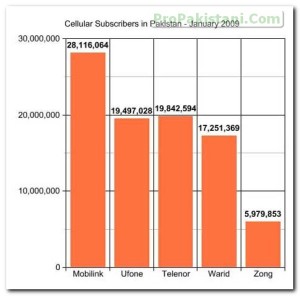 per cent), Telenor (21 per cent), Warid International (18 per cent), Zong-Paktel (2 per cent) and Instaphone (1 per cent). According to Telecom Quarterly Review (TQR) released by Pakistan Telecommunication Authority (PTA), investment worth $833.2 million was made by these cellular operators during the first half (July-December 2008) of the current financial year.
per cent), Telenor (21 per cent), Warid International (18 per cent), Zong-Paktel (2 per cent) and Instaphone (1 per cent). According to Telecom Quarterly Review (TQR) released by Pakistan Telecommunication Authority (PTA), investment worth $833.2 million was made by these cellular operators during the first half (July-December 2008) of the current financial year.
The World Bank estimates that it takes about 50 days only to get a phone connection in Pakistan.
PTCL is the incumbent operator in Pakistan, which launched Internet services in 2000. The company started offering DSL in June 2007, prior to which it offered DSL services via its subsidiary Paknet. PTCL claims to have the largest reach in broadband service availability. When it started out in June 2007, broadband services were only available in three major cities. By late October 2008, PTCL offered services in 108 cities and communities.
Telecom sector in Pakistan has tremendous potential to grow despite world economic recession, which was concluded at the 2009 Global Tele-Com Pakistan conference held by Shamrock Conferences International. Chairman, Pakistan Telecommunication Authority (PTA), Dr Muhammad Yasin stated this while addressing the conference.
The PTA has done great job in the last four to five years and achieved the most important ingredients of deregulation, which is a state of the art infrastructure and low cost access to services. He said the regulations and government intervention by introducing the policies have played their role and now the businesses and entrepreneurships need to continue by using the ICT services of communication and internet.
Broadband Internet Growth
Pakistan is ranked fourth in terms of broadband Internet growth in the world, as the subscriber base of broadband 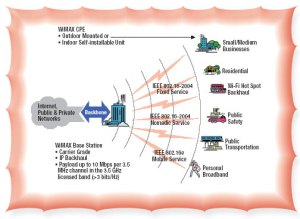 Internet has been increasing rapidly with the total base crossing 170,000 in the country.
Internet has been increasing rapidly with the total base crossing 170,000 in the country.
The rankings are released by Point Topic Global broadband analysis, a global research centre.
In Pakistan, operators are offering wide range of technologies like DSL, Cable, FTTH and Wi-Max. They have added 25,500 new broadband connections in the financial year 2007-08, which is around 150 percent increase compared to the previous financial year, Pakistan Telecommunication Authority (PTA) statistics reported.
The Internet Protocol (IP) traffic through high-speed access link has become the success factor that have made rapid the transfer of online information and communication services, data, voice and video footage. The easy way of communication owing to highly competitive market of service providers has been penetrating in the country with modest acceleration in the metropolis.
At present Digital Subscriber Link (DSL) is the leading broadband service in the county with 65 percent of the market share. Major DSL providers in Pakistan are Micronet, LinkDotNet, CyberNet, MultiNet and PTCL.
Hybrid Fibre-Coaxial (HFC) is the second largest broadband technology in terms of the market share. Approximately 25 percent of the total broadband subscribers are using HFC technology. WorldCall (Pvt) Ltd is the largest provider of Cable Modem Broadband in Pakistan through its widespread HFC network in Karachi and Lahore. Wateen Telecom is another service provider which is providing HFC service in the country.
Global broadband market analysis has shown that subscribers base for FTTH technologies is increasing sharply with the emergence of innovative applications and services such as IPTV. These new services require very high access connectivity that can only be provided through FTTX technologies.
According to the PTA annual report 2008, operators have started offering FTTH and WiMax services in metropolitan cities. At present, there are approximately 2,800 FTTH and 2,000 WiMax subscribers.
A significant reduction in subscription and services charges has been witnessed in the country. The DSL subscription rate has declined to $15 (nearly Rs1200) per month from $55 (above Rs 4,000) per month for 512Kbs connection. Subsequent to the introduction of high-speed broadband access in early 2000, telecommunication companies have started offering a whole new variety of services.
Local Loop Sector
PTCL is the incumbent operator in Pakistan, which launched Internet services in 2000. The company started offering 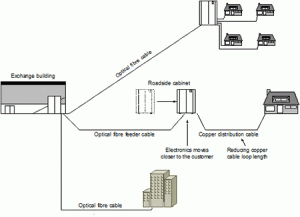 DSL in June 2007, prior to which it offered DSL services via its subsidiary Paknet. PTCL claims to have the largest reach in broadband service availability. When it started out in June 2007, broadband services were only available in three major cities. By late October 2008, PTCL offered services in 108 cities and communities.
DSL in June 2007, prior to which it offered DSL services via its subsidiary Paknet. PTCL claims to have the largest reach in broadband service availability. When it started out in June 2007, broadband services were only available in three major cities. By late October 2008, PTCL offered services in 108 cities and communities.
The local loop sector also witnessed significant development following the investment and it is expected that the investment trend will continue during the next five years due to the high growth potential of the Pakistani telecoms market. In mid-2008, the Local Loop installed capacity reached around 5.5 million, but it is predicted that DSL technology may not be able to cater for future broadband needs. This leaves a huge investment potential in optical fiber and wireless broadband access technologies.
According to the regulator, fixed line operators including wireless local loop (WLL) covered only 6.6 per cent of the potential customer base by 2008 and is expected to reach 100 million by 2010. Furthermore, since 66 per cent of potential customers live in rural areas, this offers high growth opportunities for WLL and mobile operators. Market potential is also reflected in the telecoms sector revenues which grew by 21 per cent during 2006-07.
Telecom operators in Pakistan
Pakistan Telecommunication Company Ltd has emerged as a successful Forbes 2000 conglomerate with over $1 billion in sales in 2005. In addition, there are over 3.5 million landlines in the country. As a result, Pakistan won the prestigious Government Leadership award of GSM Association in 2006. PTCL launched Internet services in 2000 and the company started offering DSL in June 2007.
In Pakistan, following are the top mobile phone operators:
- Mobilink (Parent: Orascom, Pakistan/Egypt)
- Ufone (Parent: PTCL, Pakistan/UAE)
- Telenor (Parent: Telenor, Norway)
- Warid (Parent: Dhabi Group, UAE)
- Zong (Parent: China Mobile, China)
- Instaphone
Mobilink GSM is the brand name used by Pakistan Mobile Communications (Pvt.) Ltd, a joint venture of Motorola Inc (USA), IWC (International Wireless Communications) and Saif Telecom. Mobilink provides the widest coverage network, covering more than 10,000+ cities, towns, and villages across Pakistan. Mobilink also provides true International Roaming in over 130 countries with more than 300 partner operators worldwide. Mobilink GSM – Pakistan’s first and only digital mobile network operator – has standardized on Team-POINT customer relationship management (CRM) software for a newly-enhanced, multi-million-dollar call centre. The software – from Dublin-based CRM pioneer POINT Information Systems – is part of a major upgrade and integrates Mobilink’s sales, billing, credit, helpline and technical support services. Mobilink further intends to invest $500 million in infrastructure development and service quality improvements. Mobilink subscribers increased to become 28.2 million. TQR reports that Mobilink made an investment of $111 million in Q1 (1st Quarter) and $104 million in Q2 (2nd Quarter) of 2008-09.
The company commenced its operations, under the brand name of Ufone, from Islamabad on January 29, 2001. As a consequence of PTCL’s privatization, 26% of its shares were acquired by Emirates Telecommunication Corporation (Etisalat). Being part of PTCL, the management of Ufone has also been handed over to Etisalat. Ufone has network coverage in more than 5885 locations and across all major highways of the country. Ufone currently caters for International Roaming to more than 230 live operators in more than 130 countries. GPRS Roaming facility is available with more than 115 Live Operators across 85 countries. The company has also been awarded a new License for providing cellular services in Azad Jammu & Kashmir and Northern Areas. It has a subscriber base of 19.4 million. TQR reports that Ufone made an investment of $3.2 million in Q1 and $72 million in Q2 of 2008-09.
Telenor Pakistan is a wholly-owned subsidiary of Telenor Norway. On 14 April 2004, Telenor was awarded a GSM license to build and operate a mobile network in Pakistan. On 15 March 2005, a full multimedia platform for commercial mobile services was launched under the name of Telenor Pakistan. As at 01 January 2008, Telenor Pakistan had 19.8 million mobile subscriptions. TQR reports that Telenor made an investment of $83.8 million in Q1 and $233 million in Q2 of 2008-09.
Warid Telecom is a joint venture between Abu Dhabi Group & SingTel Group. Abu Dhabi Group entered into a strategic alliance with Singapore Telecom. Subsequent to this transaction in July 2007, telecom giant SingTel acquired 30% percent equity stake in Warid Telecom, Pakistan, for US$758 million. Warid Telecom (Pvt.) Ltd. has confirmed the injection of $250million equity by its joint shareholders Abu Dhabi Group and SingTel. Warid has aggressively penetrated the Pakistan mobile communication services market with huge capital expenditure, which has enabled it to capture market share of 18.8% (as of Dec 08’) and coverage in over 450 cities and 7200 towns across Pakistan. Warid is providing voice and data communication services through its premier GSM and GPRS/EDGE network with the best voice clarity and connectivity since May 2005. Warid has a subscriber base of 17.2 million. TQR reports that Warid made an investment of $124 million in the Q1 of 2008-09.
China Mobile Pakistan (CM–Pak) is a 100% subsidiary of China Mobile. The pioneering overseas set up of China Mobile came through acquisition of a license from Millicom to operate a GSM network in Pakistan. In February 2007, Paktel was acquired by China Mobile Communications Corporation (China Mobile), for US$ 450 million, and which has aggressive development plans for the Pakistani telecoms market. CM-Pak has invested more than US$ 700 million in the telecom sector in Pakistan and an additional US$ 800 million will be invested till the end of year 2008. CM-Pak’s edge comes from the experience and expertise of running the world’s largest telecom service – China Mobile in China – which is the world’s largest telecom operator, having a customer base of over 300 million customers, its network routes 700 million text messages every day and handles 250 million calls every hour. CM-Pak is geared to offer neatly packaged VAS products that will benefit the individuals, corporate as well as small businesses. Led by a team of professionals from the field of cellular communication, CM-Pak already has a subscriber base of 5.97 million.
Instaphone introduced Pakistan to mobile telephony in 1991. Instaphone’s cellular infrastructure is based on TDMA technology to an ever expanding network of 185 Cities.
Revenues of PTCL and Cellular Phone Operators
Pakistan Telecommunication Company Limited (PTCL) earned Rs 9.151 billion net profit for the year ended June 30, 2009 against Rs 2.824 billion in 2008.
Cellular mobile operators have earned Rs 104.090 billion revenue during the first half (July-December) of the 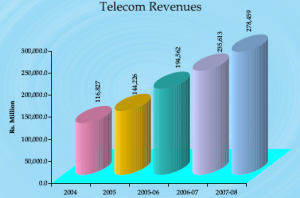 current financial year 2008-09. According to Telecom Quarterly Review (TQR) released by Pakistan Telecommunication Authority (PTA), investment worth $833.2 million was made by these cellular operators during the first half (July-December) of the current financial year.
current financial year 2008-09. According to Telecom Quarterly Review (TQR) released by Pakistan Telecommunication Authority (PTA), investment worth $833.2 million was made by these cellular operators during the first half (July-December) of the current financial year.
The companies although suffered lower profits during the 2nd and 3rd quarter of 2008, however, the year ended with much stability and growth in the industry’s total revenue. The dip was actually due to the price was sparked by ZONG in 2nd quarter of 2008, where the incumbent operators Mobilink, Telenor and Warid revenues showed negative trend in the very next quarter. Mobilink attributes its decline to increased taxes, inflation in the market and intense marketing activities of competitors. Telenor also described drop in revenues in the 3rd quarter to increased network cost and higher sales and marketing due to intensified competition in the market.
Although, the aggressive entry of ZONG in local market had pushed the profit margins of incumbent operators down to some extent, but the mobile companies actually faced major dip in the ARPU’s after Pakistani Rupee was depreciated up to 26 percent in Jul-Sept, 2008 and the tax rate was increased from 15 percent to 21 percent. Mobilink and Telenor turned out to be the only companies that are maintaining their ARPU’s at around $3, whereas the rest of the companies could not maintain their ARPU over $2. The consolidated industry ARPU in the reported period Sept, 08 to Dec, 08 was around $2.5 as compared to around $3 in the same period of 2007.
According to independent analyst firm Research and Markets Report “Pakistan Mobile forecast 2008-10, the ARPU of Pakistan mobile industry would continue to see reductions in ARPUs over the forecast period of 2008-2010. In 2010, we forecast that Pakistan will have the average ARPU level of $2.66, however, the country would keep increasing the penetration levels and would become most highly penetrated market in South Asia.” Review said.
Import of Mobile Phones
The country imported cell phones worth $139.480 million during July 2008 to March 2009 period of the current 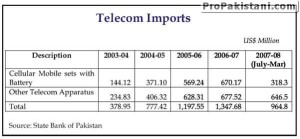 fiscal year against the phones import of $581.807 million during the same period of last fiscal year, depicting a decline of $442.327 million or 76 percent, according to Federal Bureau of Statistics.
fiscal year against the phones import of $581.807 million during the same period of last fiscal year, depicting a decline of $442.327 million or 76 percent, according to Federal Bureau of Statistics.
Manufacturers of mobile handset have proposed policymakers to reduce duties on the cell phones in order to minimize the burden on customers and to increase business in the country. They were of the view that invariably high taxes are impeding the growth of this market. The teledensity in Pakistan has reached 60 percent but the high taxes are proving to be a hurdle in its further growth. However, they were not interested to build up their manufacturing units in Pakistan as majority of them have been facing tough financial setback on the slump in demand all over the world.
The drop is attributed by the industry to Rs 500 customs duty per set imposed in the last budget and a regulatory duty of Rs 250 introduced in August 2008.
It has been suggested by the concerned in the Industry that duties on the mobile handset should be fixed on different slabs and small and cheap handsets should be exempted.
World Internet Growth
Point Topic Global broadband analysis, a global research centre, released its rankings. According to the statistics,  there are around 382. 4 million broadband subscribers worldwide by the end of August 2008 as compared with 317 million in August 2007, showing 17 percent growth.
there are around 382. 4 million broadband subscribers worldwide by the end of August 2008 as compared with 317 million in August 2007, showing 17 percent growth.
Regional Broadband trend revealed that Western Europe has the largest share of broadband users with 26 percent followed by North America at 22 percent. South and East Asia regional is in the third place with 22 percent share.
Pakistan is ranked fourth in terms of broadband Internet growth in the world, as the subscriber base of broadband Internet has been increasing rapidly with the total base crossing 170,000 in the country.
Related Links:
Pakistan ranks 4th in Broadband Internet Growth
Telecom sector tremendous potential despite World Recession

Pingback: Valuable Internet Information
we are a publication IT&T Vibrant on IT and Telecommunication, can v please print this report in our publication by the credit line of urs.
Dear Mujahid Asim,
Many thanks for visiting ‘Economic Pakistan’. You are welcome to print this report in your publication, yes, kindly mention the name of the author/compiler ‘Mirza Rohail B’ as credit.
Welcoming you at Economic Pakistan!
Thanks and Regards!
Ufone UConnect is a first of its kind service in Pakistan which allows you to perform a host of activities such as PUSH EMAIL from 5 simultaneous email accounts, have remote access to multiple Computers, share folders, search files & emails along with taking Control of your PC remotely via your handset.
These amazing features come with the added benefit of a secured server communication with latest encryption techniques and FREE data space of 512MB for folder sharing for every new customer sign-in.
uconnect.ufone.com
Pingback: Cherish President Musharraf « Our leader – Musharraf
very nice. thax………..
Pingback: Overall Vision of Our leader – Musharraf | Our leader - Musharraf
Pingback: President Musharraf’s Vision and Achievements of his tenure | Our leader - Musharraf